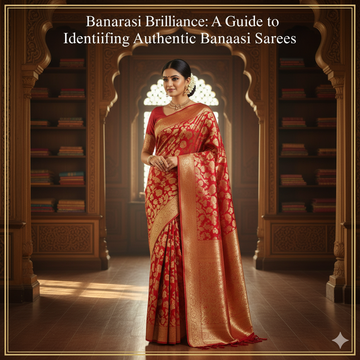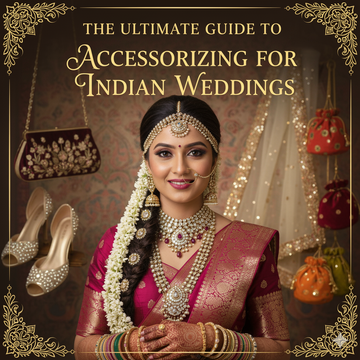Banarasi Brilliance: A Guide to Identifying Authentic Banarasi Sarees
by Joelpaes . on Oct 01, 2025

The rustle of a Banarasi saree is unlike any other. It carries centuries of legacy within its folds. The beauty of zari work is breathtaking, catching light like liquid fire, and the depth of brocade patterns speaks of royal traditions. Yet in today’s markets flooded with imitations, identifying a true handwoven Banarasi can feel like walking through a maze. Let's walk through the finer details, with cues you can trust, when searching for the real brilliance of Varanasi silk.

The Legacy of Banaras in Every Thread
Banaras, today known as Varanasi, has been a hub of silk weaving for over 500 years. Mughal patronage brought an unmatched refinement to weaving practices, giving birth to the pure silk Banarasi that became the attire of choice for nobility. These sarees were never just garments; they were heirlooms, woven with care to last for generations. When you hold a true Banarasi saree, you are not just wearing fabric but carrying forward a legacy where each loom is a storyteller.

Brocade: The Heart of Banarasi Weaving
A hallmark of any pure silk Banarasi is its brocade. Brocade refers to the raised patterns woven into the fabric, often using gold or silver threads. Unlike printed or machine-made designs, brocade in a handwoven Banarasi feels textured and almost sculptural. Run your fingers across it and you will notice a subtle unevenness, a gentle reminder that a human hand guided every movement of the loom. Geometric motifs, Mughal-inspired florals, and iconic paisleys often dominate, giving the saree both grandeur and depth.

Zari Work and its Distinct Glow
The most striking feature of a Banarasi saree is its zari work. Zari is the metallic thread, traditionally made from real silver coated with gold, that adds the luminous gleam so characteristic of Varanasi silk. Authentic zari work does not scream with brightness; instead, it glows with a soft, dignified radiance. Fake metallic threads, on the other hand, look gaudy and peel with time. Hold the saree under natural light, and you will see how the genuine zari catches sunlight in a warm reflection rather than a harsh shine.

Signs of a Handwoven Banarasi
Machine-made versions may look convincing at first glance, but their flaws reveal themselves on closer inspection. A handwoven Banarasi will often have floating threads at the back, an imprint of the painstaking weaving process. Look at the reverse side of the pallu or border; the threadwork should show irregularities, which are marks of authenticity. Machine-made sarees tend to be too neat, almost sterile. Another cue lies in weight. A real pure silk Banarasi with rich brocade and zari work carries a heaviness that feels luxurious when draped, unlike the feather-light imitations.

Patterns that Tell Stories
The motifs of Banarasi weaving are not chosen at random. Each has a history. The kalga and bel, leafy and floral motifs, trace their inspiration to Mughal gardens. The shikargah, depicting hunting scenes, speaks of royal pastimes. Even the small butti scattered across the body of the saree carries meaning, often symbolizing fertility, growth, and celebration. When you identify these motifs in a handwoven Banarasi, you are reading a language of symbols passed down through artisans over centuries.

The Role of Varanasi Silk
Varanasi silk forms the base of every genuine Banarasi saree. This silk is prized for its strength and sheen, giving the fabric a richness that endures over years. Unlike synthetic blends, Varanasi silk does not lose its luster or feel thin over time. To test it, gently rub the fabric between your palms; real silk becomes warm due to friction, while synthetic blends remain cool. The difference is not just tactile but deeply tied to the authenticity of the saree itself.

Price and Provenance
While price is never the sole indicator of quality, genuine handwoven Banarasi sarees are rarely inexpensive. The effort of weeks, sometimes months, of weaving by skilled artisans cannot be compressed into mass-produced rates. Always ask about the origin of the saree. Sellers who can trace their pieces back to Varanasi looms usually have a stronger claim to authenticity. Certificates of origin or government seals can also serve as safeguards when you invest in such heirlooms.

Caring for Your Banarasi
A true Banarasi saree is an investment in beauty, and it deserves care equal to its worth. Store it in a muslin cloth to allow the fabric to breathe. Keep it away from direct sunlight, which can dull the zari work. Refold it occasionally to prevent permanent creases. Such care ensures that your saree will remain a treasured part of your wardrobe and even something you can pass on to the next generation.
To identify a genuine Banarasi saree is to listen closely to its whispers: the weight of pure silk Banarasi, the glow of zari work, the raised life of brocade, and the heritage carried in its motifs. Each authentic piece tells of a weaver in Varanasi who poured months of skill into bringing it to life. When you drape one, you are not simply wearing fabric; you are embracing centuries of artistry that still shimmer today.
Banarasi's brilliance does not fade; it endures, thread by golden thread.




